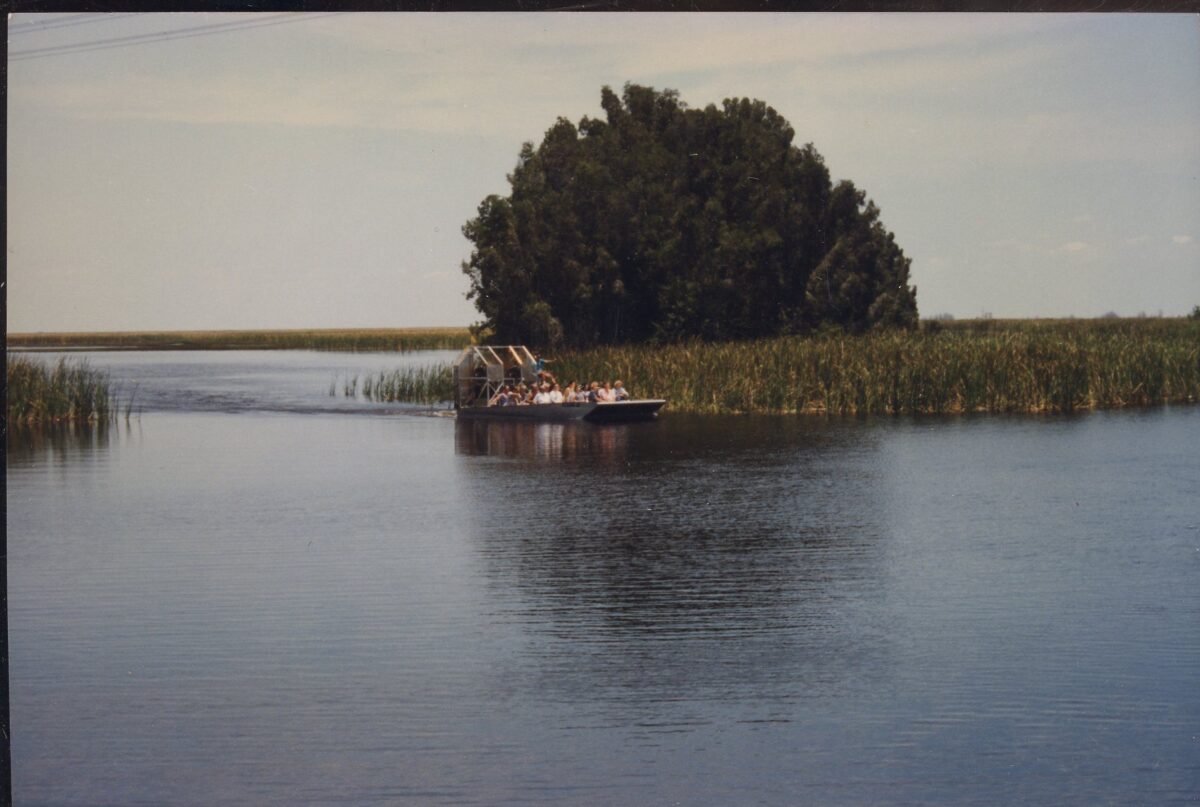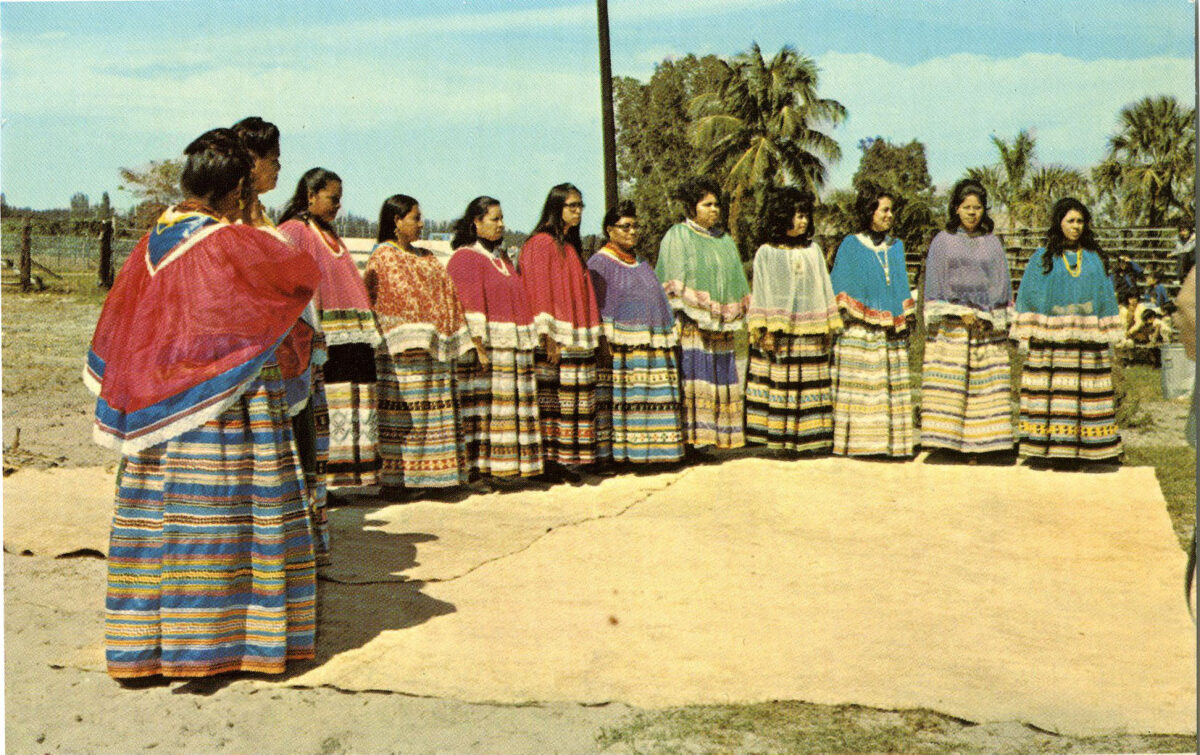
Seminole Spaces: Okalee Indian Village
Welcome to the first installment of a new, intermittent series called Seminole Spaces! In this series, we will explore places and spaces important to Seminole history, culture, and tourism. This week, we are shining a spotlight on the Okalee Indian Village, and specifically the Okalee Arts & Crafts Center. The Seminole Tribe of Florida opened Okalee as its first official business venture in the 1950s. Okalee means “camp” or “village”.
In our featured image, you can see a postcard of a statue outside the original Okalee Arts & Crafts Center. The Seminole man statue (Jackie Willie) reaches out and places a hand on top of a large alligator. This memorable, iconic statue would be an image for the Seminole Tribe of Florida for years to come. Additionally, the statue calls back to the Seminole Pointing Man signs of the 20s and 30s, enticing visitors from their cars to stop for a visit.
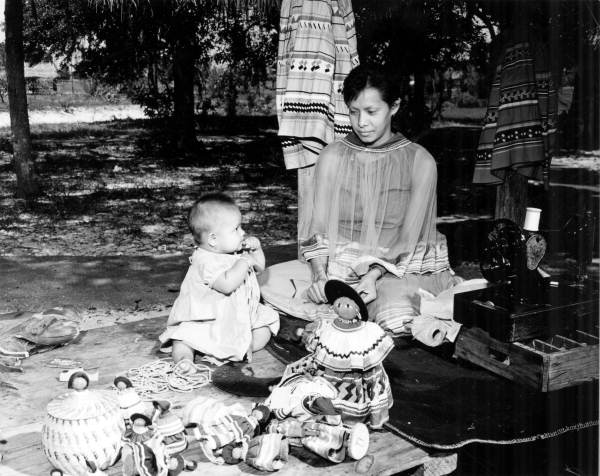
Barron, Charles Lee, 1917-1997. Minnie Doctor and child with Seminole dolls at the Okalee Indian Village on the Dania Reservation. 1961. State Archives of Florida, Florida Memory.
The Opening of Okalee
The Okalee Indian Village opened in the Hollywood (previously Dania) Reservation in the late 1950s. In 1957, tribal leaders developed a constitution, which established a two-tiered government composed of a Tribal Council and Board of Directors. Both would have an elected representative from every reservation community. That same year, the U.S. Congress would officially recognize the Seminole Tribe of Florida on a federal level. This recognition would cement the Seminole Tribe of Florida’s sovereignty in the eyes of the U.S. Government, and would finally bring full economic and political agency. In many ways, the opening of Okalee was the first step in seizing this agency after federal recognition. Those at Okalee took the lessons and triumphs of the past and built the financial future of the Seminole Tribe of Florida.
The Tribe built Okalee primarily as a tourist attraction. They intended the village at Okalee was to share a slice of Seminole life. They built numerous chickees, where men and women would demonstrate arts, crafts, and various tasks from daily life on the reservations. Additionally, they included a small zoo on the property, complete with alligator wrestling pits. In many ways, Okalee was a “classic Seminole Indian attraction” focused on Seminole crafts, art, alligator wrestling and demonstrations (West 230). Below, you can see a black and white photo from the Ah-Tah-Thi-Ki Museum Collection. Walter Huff (Dixie) poles a canoe through the canal at the Okalee Indian Village, circa 1960. Huff was employed to pole a Seminole dugout canoe through the canals for visitors when Okalee first opened on the Hollywood (Dania) Reservation.
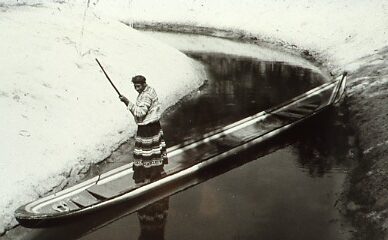
GRP1896.221, ATTK Museum
Seminole Agency at Okalee
The opening and operation of Okalee sits at a pivotal time in Seminole history. The Seminole Tribe of Florida had obtained federal recognition and was working to establish itself economically. Okalee was the first official step towards the modern Seminole Tribe of Florida we know today. But, beyond economics, Okalee also represented one more example of Seminole perseverance, defiance, and determination in the face of fierce opposition.
In our previous blog post on the 1940s, we briefly discussed how vocal opponents to Seminole attractions appeared under the banner of altruism. People like Deaconess Harriet Bedell, and the U.S. government, tried to manipulate and disband Seminole attractions as ‘inappropriate’. To Bedell, this meant controlling what crafts and styles were bought and sold. Meanwhile, the government’s “idealistic plans for these Native Americans were in direct opposition to the job descriptions at the attractions, and…Seminole will.” (West 211)
It is no misstep, then, that Okalee opened as a classic representation of Seminole tourist attractions. It was complete with zoo, alligator wrestling pits, a modern crafts building, and even Seminole wedding reenactments. Below, you can see a photo from a Miami Herald article from August 20, 1960, detailing a Seminole wedding reenactment at Okalee between Onnie Shore and Edward Osceola. Performed for tourists, the wedding was sandwiched between alligator wrestling shows.
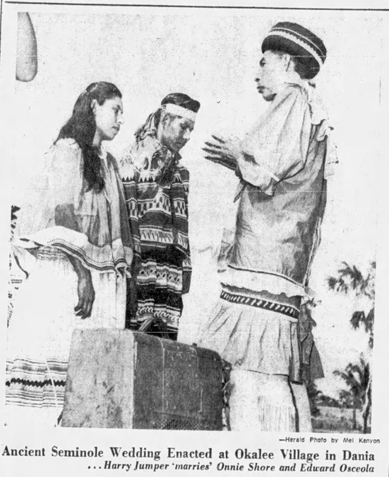
By leaning into Seminole attractions, Okalee firmly placed Seminole will and agency at the forefront of the new Seminole Tribe of Florida. This was theirs, it was Seminole, and it was something that would not be manipulated or cajoled away. Okalee Indian Village “ironically…was located near the former sire of the old Seminole Agency Building…where Special Commissioner James L. Glenn and others had bemoaned what they perceived as the demeaning exploitation of the Seminoles on exhibition” (West 230). Once more, Seminoles remained unconquered.
The Okalee Indian Arts & Crafts Center
An especially important feature at Okalee was the Okalee Indian Arts & Crafts Center, which opened in Spring 1960. The entrance to the original Arts & Crafts Center can be seen in our featured photo above. Located on the corner of US441 and Stirling Rd in Hollywood, according to a 1960 Miami News article, the sprawling building cost $200,000 to construct (Miami News, April 03, 1960). Boasting it was “the only authentic establishment of its type in the United States,” the article describes colorful and intricate arts and crafts against the backdrop of the thatched-roof chickees of Okalee Village.
Tourists could peruse authentic Seminole arts and crafts in the 3500 sq. foot building, take in an alligator wrestling show, or even watch someone crafting. Below, Morgan Smith demonstrates the making of buckskin clothing under one of the chickees at the Okalee Seminole Indian Village on the Hollywood (Dania) Reservation in 1960.
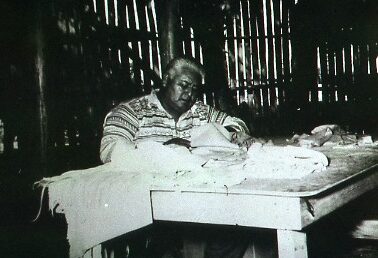
GRP1896.128, ATTK Museum
The A-framed building and exposed roof rafters reaching to the ground made it memorable and architecturally distinct. With a fully glass front entrance, today’s Ah-Tah-Thi-Ki Museum shares a striking resemblance to the long-gone building. Truthfully, the Okalee Indian Arts & Crafts Center sowed the seeds for what the Ah-Tah-Thi-Ki Museum and Okalee Museum would eventually become.
Below, two women and children sit around a camp fire and cook skin-on fish. To the left in the colorful cape, Mrs. Ada Tiger holds a cast iron pot over the flames. Ada Tiger was the mother of Betty Mae Jumper. Agnes Jumper, with her two sons, sits to the right. Women set up this camp scene every day for tourists, so they could observe what a traditional Seminole camp looked like.
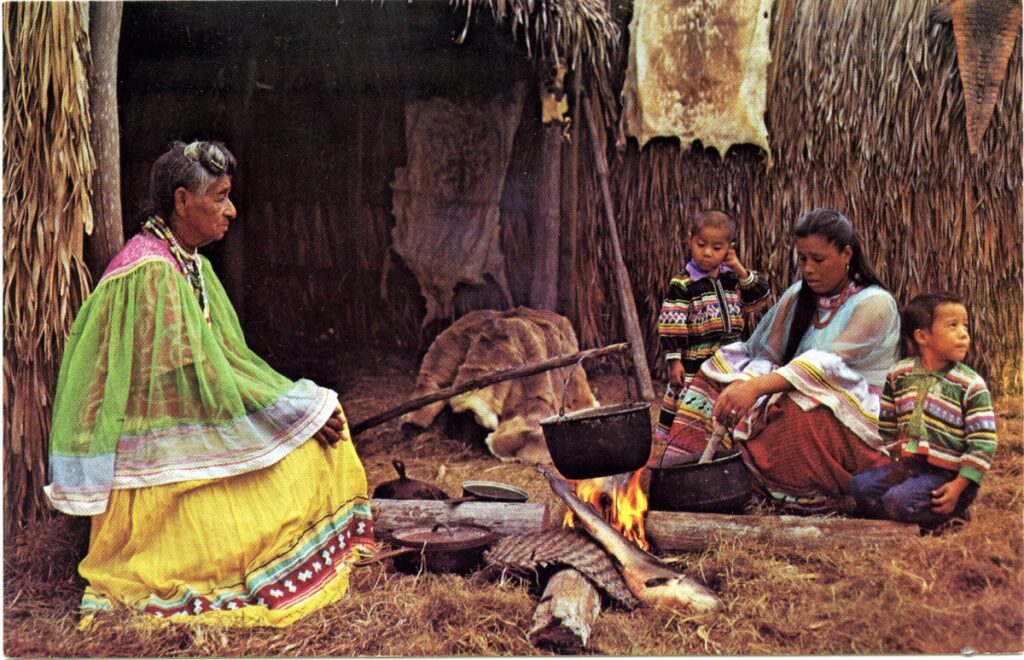
2003.15.258, ATTK Museum
An Icon in the Making
The original Okalee village went out of business in 1978, but re-opened briefly in 1986. A fire later destroyed Okalee. But, the giant Seminole and alligator were saved and placed in the new Okalee village. The Tribe opened the new village in 1998 in what would become Seminole Paradise. This second village, which opened one year and one day after the Ah-Tah-Thi-Ki Museum, included its own museum space, with buildings for artifacts and a full village recreation. The Ah-Tah-Thi-Ki Museum operated a smaller satellite facility within the Seminole Paradise area of the Seminole Hard Rock Hotel and Casino in Hollywood from 2005-2009 next to Okalee.
In a Miami Herald article from 1998, the director of the Seminole Tribe of Florida’s Office of Planning and Development, L.D. Baxley Jr., noted his wish that the Okalee Museum would entice visitors to drive out to the Ah-Tah-Thi-Ki Museum. Baxley “hoped visitors to the Okalee site will use it as a preview of Seminole culture, before driving 70 miles on Interstate 75 to visit the Big Cypress Museum” (Miami Herald, August 14, 1998). Okalee would undergo another closing in 2014, only to reopen again in 2019 to much fanfare.
In a Seminole Tribune article covering the 50th Anniversary celebration of Okalee Village in 2010, its legacy was on the forefront of many people’s minds. Hollywood Tribal Council Representative Max B. Osceola Jr. stated, “It’s our own Smithsonian, kind of, I have always looked at it as a place for cultural exchange. It is also a link to our past.” In the same article, Chairman Cypress stated “It has come a long way over the years. It turned out to be the biggest money maker for the Tribe at the time.”
Okalee Today
Although the original structures are gone, Okalee is still an important and useful space full of Seminole history and culture. The Seminole Tribe of Florida rebuilt the building and grounds. Today, it is still a museum space used for museum events, exhibits, and gatherings. Much like when it reopened in 1998, the hope is to introduce people to Seminole history and culture, and to encourage them to travel to the Ah-Tah-Thi-Ki Museum on the Big Cypress Reservation. Okalee Village features special exhibits from the Ah-Tah-Thi-Ki Museum, a Culture Camp, and Seminole Village. Recently, Okalee Village was used for part of the Seminole Artist Experience Art Sale and Earth Day events.
Additional Sources
The author accessed these sources digitally. Page reference numbers may not align with paper and hardback copies.
West, Patsy. The Enduring Seminoles: From Alligator Wresting To Casino Gaming, Revised and Expanded Edition. 2008. University Press of Florida. Digital.
Author Bio
Originally from Washington state, Deanna Butler received her BA in Archaeological Sciences from the University of Washington in 2014. Deanna moved to South Florida in 2016. Soon, she began working for the Seminole Tribe of Florida’s Tribal Historic Preservation Office. Deanna was the THPO’s Archaeological Collections Assistant from 2017-2021. While at the THPO, Deanna worked to preserve, support, and process the Tribe’s archaeological collection. She often wrote the popular Artifact of the Month series, and worked on many community and educational outreach programs. She lives in Fort Myers, FL with her husband, son, and dog.


